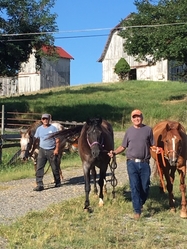L-R Dr. Mary Cwik, Dr. Tami DeCoteau, Dan Press, Dr. Zach Kaminsky, photo courtesy of Elizabeth Prewitt
In 1964, Dan Press was in his first year of law school and was not liking it; he wanted a way out. He applied for a volunteer spot with AmeriCorps VISTA, the domestic version of the Peace Corps, and was intrigued by a position on an Indian reservation.

“I knew nothing about Indians, but it sounded like a good opportunity,” says Press, who was raised in Flushing, in the Queens borough of New York City. “So, I signed up and the next thing I knew I was on a plane to Montana,” he says.
It was a move that changed the course of his life.
Press, an attorney and now 78 years old, has spent his entire working life fighting on behalf of Indian tribes. He helped found the Tribal Employment Rights Office in 1977, which now has 300 offices around the country. His first legal battles involved pushing for enforcement of laws passed a half a century earlier to give Native Americans preference in hiring for employment on Indian lands brought by outside agencies and firms, but until Press challenged practices and won, those laws were largely ignored.
During his long legal career from working for The Navajo-Hopi Legal Services Program for the Navajo Nation in Arizona to his work at Van Ness Feldman, a law firm in Washington, D.C., he’s also counseled Indian tribes in advancing legislation that’s resulted in hundreds of millions of dollars in land settlements and the procurement of new health facilities. He helped found the first intertribal bank in the nation. Press has also been a champion of promoting trauma-informed initiatives, which in 2018 earned him a Public Advocacy award from the International Society for Traumatic Stress Studies for "Outstanding and Fundamental Contributions to Advancing the Social Understanding of Trauma." In addition, he is the author of "A How-To Handbook on Creating Comprehensive, Integrated Trauma-Informed Initiatives in Native American Communities."
Press is the general and legislative counsel for the Campaign for Trauma-Informed Policy and Practice (CTIPP), which helps local, county and state initiatives advocate for legislation to expand trauma-informed practices across the country. He also served as general counsel for The Roundtable on Native American Trauma-informed Initiatives. Both organizations are pro bono clients of his law firm. He has taught classes on tribal government at Columbia University, including “The Holocaust and Genocide in America”, in which students looked at common themes that arose in the genocides of Native Americans and of Jews.
On his first foray into Indian land in Montana, Press tutored children and coached basketball on the Crow Indian Reservation in the southern part of the state. While there, he was approached by Joseph Medicine Crow, the last living war chief of the Crow tribe, an oral historian and writer, who chronicled the living stories of the Crow. Medicine Crow asked Press to translate Crow treaties with the federal government into everyday language. (Medicine Crow, who won a Presidential Medal of Freedom for his war time service during WW II and for his work chronicling Crow history, died in 2016). The project was a turning point for Press. “It made me interested in Indian law,” he recalls.
Fortuitously, a couple he met in Montana who had just graduated from Yale Law School, which had coursework focused on law and society, helped him transfer from Columbia Law School to Yale, where he finished law school two years later in 1968. He then headed to the Navajo Indian Reservation in Window Rock, Arizona to take a job with The Navajo-Hopi Legal Services Program. He shed his urban roots enough to buy a horse, help friends herd cattle in his spare time, and he also attended native ceremonies.

That experience with the legal services program gave Press a window into the lives of the people he was representing. “We knew there was a lot of beauty out there; there were a lot of beautiful traditions and wonderful people who weren't reaching their full potential,” he says. Press got involved in employment law, “because I thought if people had jobs, that would help them overcome some of the problems like alcoholism and suicide and other major problems that people suffered on the reservation.”
That employment work, pushing for Indians to have preference in employment over non-Indians for jobs brought into the reservation, led to the establishment of the first Tribal Employment Rights Office in Window Rock. Although there were laws to give that preference, explains Press, “nobody every enforced them.”
When Press moved to Washington, eventually taking a job at the law firm Van Ness Feldman where he spent more than three decades, he continued to fight for Indian preference in employment.
“We had battles with federal agencies who said, ‘You can't tell our federal contractors or grantees what to do.’ Now we had to show that tribal sovereign authority was stronger than any of those federal regulations. And that tribes could tell federal contractors they have to comply with Indian preference requirements of the tribe. So, a lot of it was fighting to assert tribal sovereignty, which at that point, was still a very new concept.”
As a result of Press’s efforts to push and maintain enforcement of Indian preference law, some 300 Tribal Employment Rights Offices have sprung up around the country.
Despite these victories, Press was beginning to understand that improving employment rights among native people did not mean—as he had hoped—that the societal problems on Indian reservations would go away.
“By around 2010, I started getting very disillusioned. I noticed that 40 years after I'd left the Navajo reservation, the problems that I thought would gradually dissipate were still as bad as ever—the alcoholism and the suicide and all of the other health and social problems that the tribes lead the country in,” he recalls.
He took the problem to his Columbia University students in the first course he taught on Indian tribal government.
“The issue I put before the students is how do we explain all of this dysfunctionality that we see on reservations? Why haven't those problems decreased? We've seen an increase in college graduates, we've seen an increase in economic status, but we still have huge unemployment problems, huge substance use problems, huge suicide problems, high school dropout problems,” he says.
It was his students, says Press, who first introduced him to the concept of intergenerational and historical trauma in 2011. They had worked with professors in the university’s psychology department who were investigating how trauma from stress caused changes in genes in mice that were passed down from one generation to the next. (For an example of research around generational trauma and epigenetics, see this study. For research on Holocaust survivors and epigenetics, see this study.)
“It was after that class that I became persuaded that historical trauma was by far the most viable explanation for all for a lot of the problems that you see on reservations,” Press says.
Around the same time as the class, Press’ wife emailed him a study that she thought he should read. It was the landmark Centers for Disease Control and Prevention/Kaiser Permanente Adverse Childhood Experience Study (ACE Study) that tied 10 types of childhood trauma, such as living with a family member who’s addicted to alcohol or is depressed, with chronic disease in adulthood. The ACE Study and subsequent research also showed links between childhood trauma and alcohol and drug abuse in adulthood.
"So, I read it and thought, ‘It really connects the dots between historical trauma and these other forms of trauma’,” says Press. “I began studying more about it and I became a convert, and thought it was one of the most important studies out there.”
In 2014, a phone call with a former client would send Press on his current path. The call was with Native American psychologist, Dr. Tami DeCoteau, whom he describes as his “guru on trauma,” who called Press up one day and said, “I never mentioned it, but I used to babysit for Senator Heidi Heitkamp from North Dakota, and she just called me and said: ‘Let's have coffee. I want to just pick your brain on what issues I should be dealing with.’”
Press suggested that DeCoteau ask Heitkamp to hold a roundtable discussion on historical trauma in Indian country. Heitkamp, who said it was consistent with her interest in issues affecting children, agreed.
Press and DeCoteau brought together about 25 people in 2014 to speak, including PACEs Connection’s Elizabeth Prewitt, who described the ACE Study. DeCoteau spoke about the experience of trauma on Indian reservations, and representatives from the Menominee tribe in Wisconsin talked about their cross-sector work in implementing trauma-informed practices.
Heitkamp stayed put for a full hour of the three-hour roundtable, recalls Press. “Getting a senator to sit the whole hour was amazing… But as she walked out, she said, ‘I've walked out of this hearing room for the Senate Committee on Indian Affairs depressed so many times because of all the problems people have described. This is the first time I'm walking out optimistic that maybe we have a solution!’”
That meeting gave rise to The Roundtable on Native American Trauma-informed Initiatives in 2016. While the group, led by leaders volunteering their time, including Press, is no longer active, it held meetings to inform government officials about the merits of trauma-informed programs. It also organized conferences for Native Americans, including one entitled: Calling Upon the Warrior Spirit to Heal Historical Trauma Conference and Ceremony in 2018.
In 2017, Heitkamp, along with Illinois Senator Dick Durbin, introduced the Trauma-Informed Care for Children and Families Act of 2017. Provisions of the legislation were later included in legislation signed into law in 2018 to address the nation’s burgeoning opioid epidemic. Until she lost her reelection bid to the Senate in 2019, Press says that Heitkamp remained a staunch supporter of legislation to advance trauma-informed policy.
Around the same time, Press was introduced to Dr. Sandra Bloom, a psychiatrist who was among a group of clinicians who developed a trauma-informed practices protocol known as the Sanctuary model, which has been widely disseminated around the country in schools and organizations, and Dr. Andrea Blanch, the president and director of the Center for Religious Tolerance, who trains service agencies and communities in trauma-informed practices. The two told Press of their interest in forming a national organization with leaders from across sectors to spread the word about trauma-informed practices. They just needed a place large enough to hold the meeting. Press offered up a room at his law firm.
That conversation sparked the formation of the Campaign for Trauma-Informed Policy and Practice, and Press, who was winding down his legal practice, jumped in. CTIPP focuses on advocating for legislation that incorporates the science of positive and adverse childhood experiences (PACEs science) into federal programs and serves as a forum for trauma-informed coalitions to share ideas and resources. In February 2020, just before the COVID-19 pandemic took hold, CTIPP launched the National Trauma Campaign, which is focused on recruiting advocates for trauma-informed legislation in every Congressional district. (See the attached slide deck to learn more about the work of CTIPP.)
That effort has already produced results. “When we first started, there was really just Senator Durbin and Senator Heitkamp. Now there are probably a half dozen senators who have introduced trauma-informed legislation,” says Press. In June, Senators Durbin and Shelley Capito of West Virginia, and others introduced the Rise from Trauma Act, which would infuse trauma-informed policies into federal programs. The bill would also provide funding for community-level work on trauma-informed practices. That bill hasn’t moved yet, says Press. But he has hopes about the reconciliation bill (a.k.a. Build Back Better, click here for PACEs Connection story), which is before the House of Representatives for a vote, and includes $2.5 billion in funding, which could go towards trauma-informed community coalitions.
If that happens, he says, “we'll achieve one of our most important goals, which is to get funding to these local coalitions because they're springing up all over the country and you see them on PACEs Connection. But the thing they all struggle with is funding. We have a lot of great volunteers, but we don't have funding to hire full-time staff. So as the reconciliation bill passes with the Senate for the first time, there'll be a funding source for local trauma-informed coalitions, and that would be a huge, huge, huge win.”
Press points to the appropriations bill report that just came out of the U.S. House of Representatives as another sign of progress. It included 30 different items in which funding was provided for trauma-informed related programs.
Reflecting next steps, Press says, it’s really all about education. “We know how to help people who have suffered trauma. We know how to prevent trauma. It's really the education piece that is the biggest barrier. If we get in front of every state legislator, every congressperson, every governor for a half an hour, and go through the [positive and adverse childhood experiences] science, I think all of the barriers would just fall like crazy.”



Comments (0)